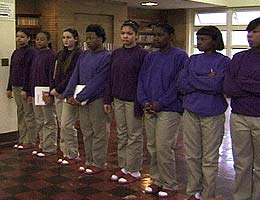|

Girl Trouble
Directors:
Lexi Leban and Lidia Szajko
U.S.,
2004
Review
by Rachel Swan
The
Center for Young Women’s Development doesn’t serve girls who are at risk, indicates Lateefah Simon, the 22-year
old single mom who executive directs the program –it serves girls who are in
risk. It is, in fact, the nation’s first leadership and employment center run entirely by young women, all of whom
have already had brush-ups with the juvenile justice system.
Even
though the number of girls in the juvenile justice system has more than doubled over the past decade –while, ironically,
the youth incarceration rate declined, overall- there is still very little public dialogue about why girls commit crimes,
and what happens to them once they enter the system. Moreover, girls only receive 2% of the services allocated to incarcerated
youth, even though they represent 28% of the juvenile prison population.
Such
was the impetus for Girl Trouble, a film that follows the lives of three young
female offenders, over a course of four years. Baby-faced Shangra is caught for selling drugs, trying to earn enough money
to look after herself, and protect her mother, who is a recovering heroine addict. Stephanie, who talks fast and claims she
has a natural ability to sell things to people (once she’s out of the system she starts attending business classes at
City College), refuses people’s offers to buy diapers for her new baby, or help her extricate herself from an abusive
boyfriend. When her relationship gets really stormy, Stephanie comes to work wearing sunglasses and a long-sleeved jacket,
to hide her bruises. Sheila is one of those traffic-stoppingly beautiful girls who seems to have no knowledge of it –she
sells and uses drugs in Sunnydale projects, where she grew up with a father and siblings who had already been in and out of
jail.
Directors
Lexi Leban and Lidia Szajko stand apart from other ethnologists, or social welfare advocates, in that they are not afraid
to let the girls speak for themselves, unaided by music or voiceover commentary. Thus, Girl
Trouble is not a typical morality tale, or even a stock populist tale: The girls talk about hardships –family violence,
poverty, drugs- but they also bring personal agency to the fore, and make no bones about it. When Sheila is locked up in a
state prison for shooting her brother, she says, matter-of-factly: “I was up for about a week (doing lines and smoking
ice). I was real hify.” This willingness to show both a bad side and a good side, -a good and bad which are, in fact,
so dependent on one another, that it seems impossible to separate them- as the girls try to negotiate the spaces they inhabit,
is what makes them believable.
Girl Trouble is less an indictment of the juvenile justice system, than a personal
glimpse at four young women as they try to understand their lives. Judges, cops, and social welfare advocates seem alternately
calloused and officiating: They are unable, ultimately, to deal with the larger social factors that contribute to juvenile
crime, such as poverty, a lack of job opportunities, and the proliferation of drugs in urban communities. And in the end,
it’s impossible to circumscribe Shangra, Stephanie, and Sheila within the “juvenile delinquent” box, because
their humanity shines through. Each girl is neither totally a criminal, nor totally a victim of circumstance; each girl just
is.
|

